ECO mode HONDA CIVIC 2022 Owners Manual
[x] Cancel search | Manufacturer: HONDA, Model Year: 2022, Model line: CIVIC, Model: HONDA CIVIC 2022Pages: 700, PDF Size: 13.98 MB
Page 4 of 700

System Updates Terms and Conditions*
General
Your vehicle has an application that allows your Display Audio to
automatically search for Honda software updates that are specific
to your Display Audio and its connected devices (initially every one
(1) week via Wi-Fi or every four (4) weeks via Telematics Control
Unit (TCU)
*, queries may occur more or less frequently due to
internet outages, retries, direct user action, WAP push from the
server or a change in query pol icy on the Honda servers). This
application periodically transmits to our servers a limited amount of
vehicle and device information (V ehicle Identification Number
(VIN), the Model Type (MT) Identi fication Number, Hardware and
Software Part Number, Serial Number , Software Version, preferred
language, Internet Protocol (IP) address, Transaction Log (alert or
update viewing, update download and installation, software
status), etc.). When the application finds an update from the server,
the application initially asks permission to download and install the
update. You may elect to automati cally download and install these
updates in your settings, or, you may elect to manually update the
system.
When your Display Audio searches our servers for updates or alerts,
we will automatically provide you with the opportunity to update
your devices or transmit the update or alert directly to your Display
Audio. We will also maintain a log of the updates or alerts that are
installed on our servers.
Your Personal Data
Should the aforementioned info rmation transmitted to Honda
constitute personal information in y our region, please note that this
information will be treated in stri ct accordance with the rules and
regulations outlined in this notice as well as applicable data
protection law. The terms of our privacy policy are
incorporated into these terms by
reference and your use of system updates will be subject to the
privacy policy. Our privacy policy se ts out information about how we
and any named third parties will pr ocess any personal data we collect
from you or that you provide to us, via the application.
See the Honda website for further details.
U.S.: www.honda.com
Canada: www.honda.ca
Honda collects, uses and stores your personal data for the reasons
set out below:
Where necessary for Honda's legitimate interests, as listed below, and
where our interests are not overridde n by your data protection rights.
●to deliver the system updates and related services to you;●to allow us to improve and optimize the system updates
products and services;
●to respond to user questions an d complaints; and for internal
record keeping.
Protecting our legitimate business interests and legal rights
includes, but is not limited to, use in connection with compliance,
regulatory, auditing, legal claims (including disclosure of such
information in connection with legal process or litigation) and other
ethics and compliance reporting requirements.
Honda will also convert personal data into anonymous data and
use it (normally on an aggregated st atistical basis) for uses such as
market research and analysis, to improve the system updates, to
analyze trends, and to assess the success of software update
releases. Aggregated personal in formation does not personally
identify you or any other use of the system updates.
Honda may share this data with Honda's worldwide support
organization or affiliated Honda companies or other third parties
engaged by Honda for the purposes of rendering support services
in connection with system support.
* Not available on all models
Page 11 of 700

Visual Index
10
Quick Reference Guide❚Power Window Switches (P 176)
❚Master Door Lock Switch (P 168)
❚Door Mirror Controls (P 197)
❚Trunk Opener (P 170)
❚Interior Fuse Box (P 666)
❚Hood Release Handle (P 597)
❚Driver’s Front Airbag (P 54)
❚Rearview Mirror (P 196)
❚HomeLink® Buttons* (P 387)
❚Passenger’s Front Airbag (P 54)
❚Wireless Charger* (P 215)
❚USB Port(s) (P 231)
❚ECON Button* (P 449)
❚Electric Parking Brake Switch (P 554)
❚Drive Mode Switch* (P450 )
❚Accessory Power Socket (P 214)
❚Glove Box (P 209)
❚Shift Lever
Continuously Variable
Transmission
(P 443, 445)
❚Auto Idle Stop OFF Button (P 454)
❚Automatic Brake Hold Button (P 558)
Page 14 of 700
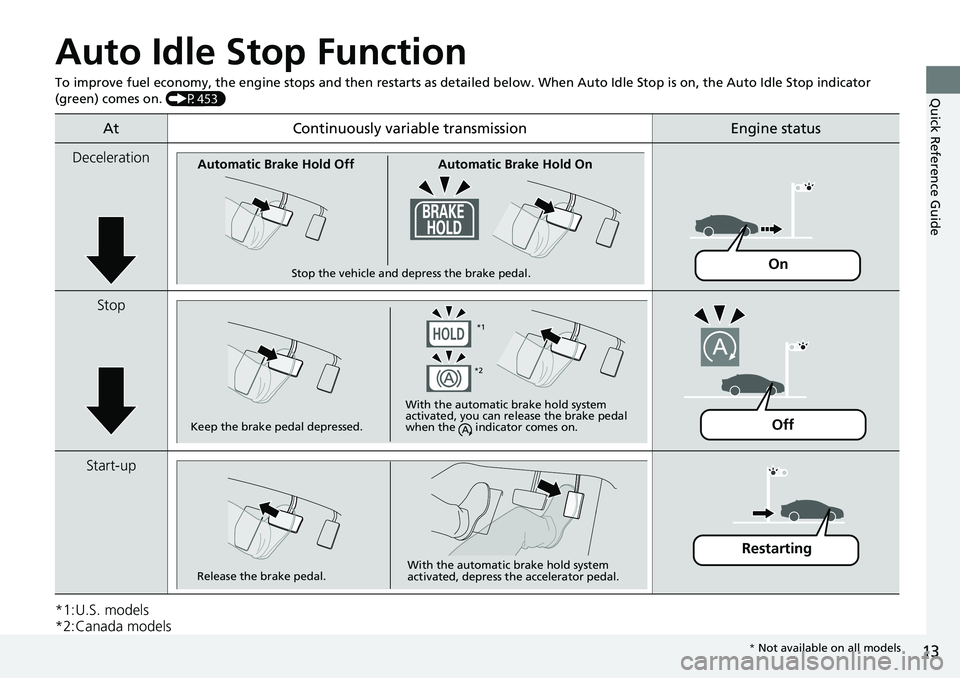
13
Quick Reference Guide
Auto Idle Stop Function
To improve fuel economy, the engine stops and then restarts as detailed below. When Auto Idle Stop is on, the Auto Idle Stop in dicator
(green) comes on. (P453)
*1:U.S. models
*2:Canada models
At Continuously variable transmissionEngine status
Deceleration
Stop
Start-up
Stop the vehicle and depress the brake pedal.
Automatic Brake Hold Off Automatic Brake Hold On
On
Keep the brake pedal depressed. With the automatic brake hold system
activated, you can release the brake pedal
when the indicator comes on.
*1
*2
Off
Release the brake pedal. With the automatic brake hold system
activated, depress the accelerator pedal.
Restarting
*
Not available on all models
Page 15 of 700

14
Quick Reference Guide
Eco Assist® System (P 449, 450)
*1:Models with A-type meter
*2:Models with B-type meter
*3:Models without drive mode switch
*4:Models with drive mode switch
Ambient Meter●With SPORT mode* off, the color of the ambient meter changes to green to indicate that the vehicle is being
driven in a fuel efficient manner.
ECON Button*3/DRIVE
MODE Switch*4
(P 449, 450)
Helps maximize fuel
economy.
ECON Mode Indicator (P 100)
Comes on when the ECON mode is
on or selected.
*1 *2
*1 *2
*3
*4 *3
*4
Ambient Meter
Page 17 of 700
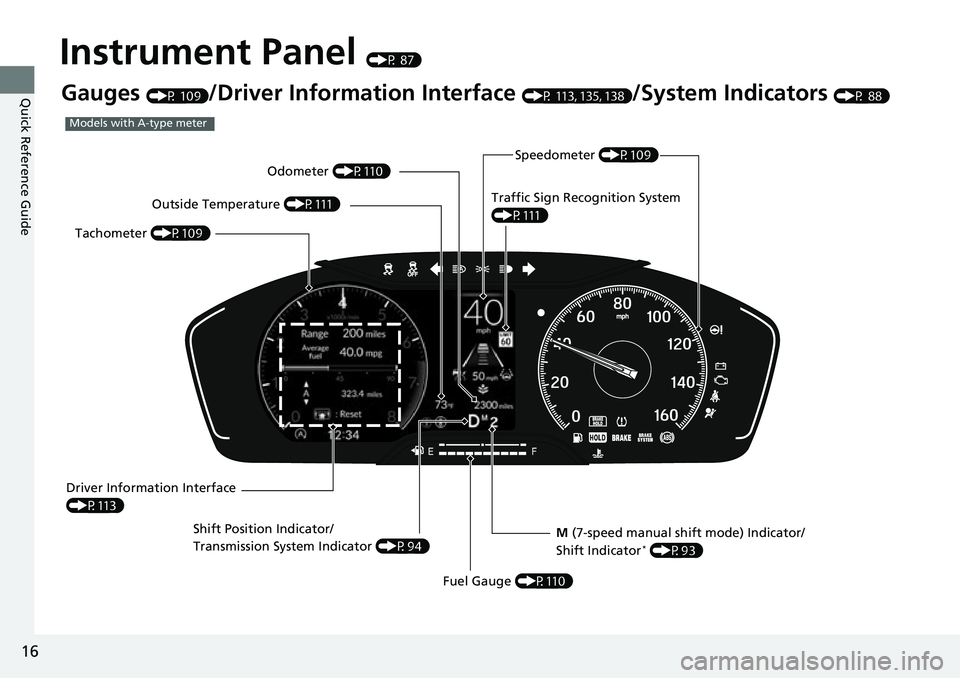
16
Quick Reference Guide
Instrument Panel (P 87)
Gauges (P 109)/Driver Information Interface (P 113, 135, 138)/System Indicators (P 88)
M (7-speed manual shift mode) Indicator/
Shift Indicator
* (P93)
Models with A-type meter
Shift Position Indicator/
Transmission System Indicator (P94)
Fuel Gauge (P110)
Driver Information Interface
(P113) Tachometer
(P109) Speedometer
(P109)
Traffic Sign Recognition System
(P111)
Odometer (P110)
Outside Temperature (P111)
Page 18 of 700
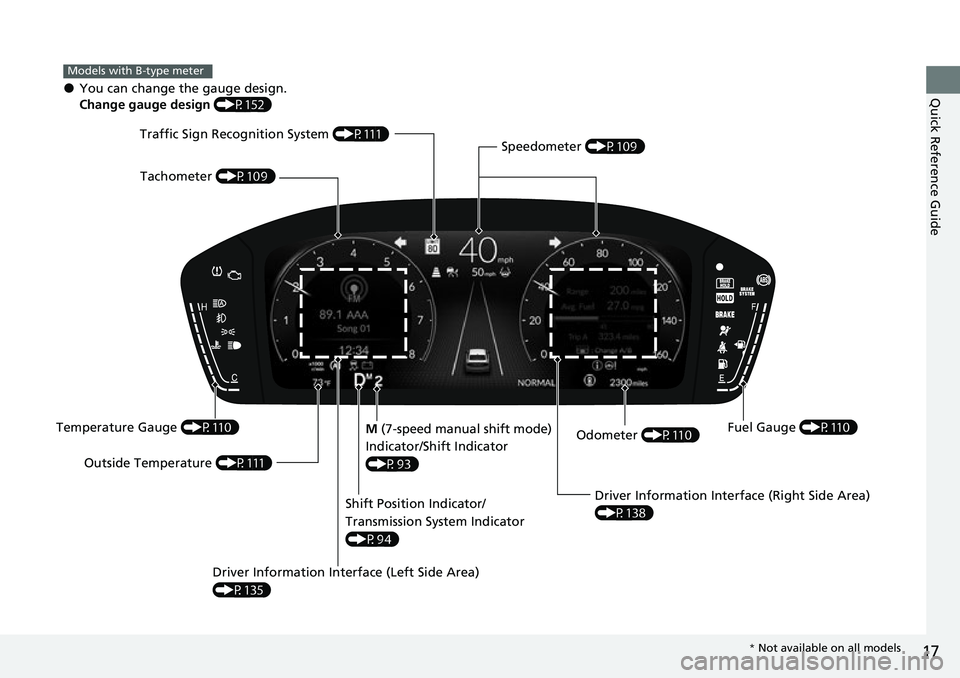
17
Quick Reference Guide
M (7-speed manual shift mode)
Indicator/Shift Indicator
(P93)
●You can change the gauge design.
Change gauge design (P152)
Models with B-type meter
Shift Position Indicator/
Transmission System Indicator
(P94) Fuel Gauge (P110)
Driver Information Interface (Right Side Area)
(P138)
Tachometer
(P109) Speedometer
(P109)
Traffic Sign Recognition System
(P111)
Odometer (P110)
Temperature Gauge
(P110)
Driver Information Interface (Left Side Area)
(P135)
Outside Temperature (P111)
* Not available on all models
Page 34 of 700
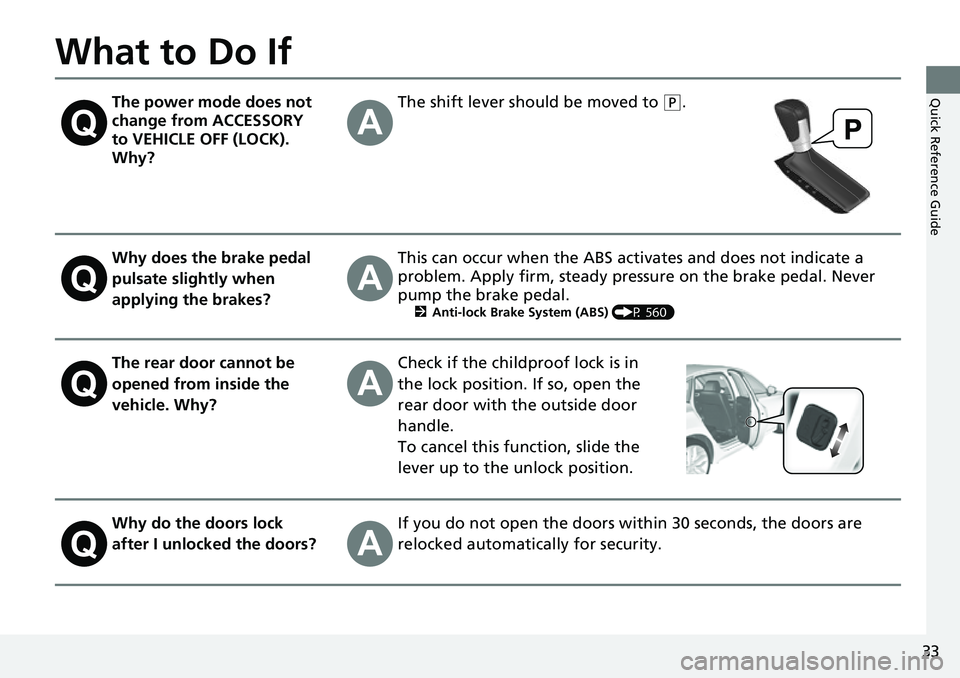
33
Quick Reference Guide
What to Do If
The power mode does not
change from ACCESSORY
to VEHICLE OFF (LOCK).
Why?The shift lever should be moved to (P.
Why does the brake pedal
pulsate slightly when
applying the brakes?This can occur when the ABS activates and does not indicate a
problem. Apply firm, steady pressure on the brake pedal. Never
pump the brake pedal.
2Anti-lock Brake System (ABS) (P 560)
The rear door cannot be
opened from inside the
vehicle. Why?Check if the childproof lock is in
the lock position. If so, open the
rear door with the outside door
handle.
To cancel this function, slide the
lever up to the unlock position.
Why do the doors lock
after I unlocked the doors?If you do not open the doors within 30 seconds, the doors are
relocked automatically for security.
Page 45 of 700
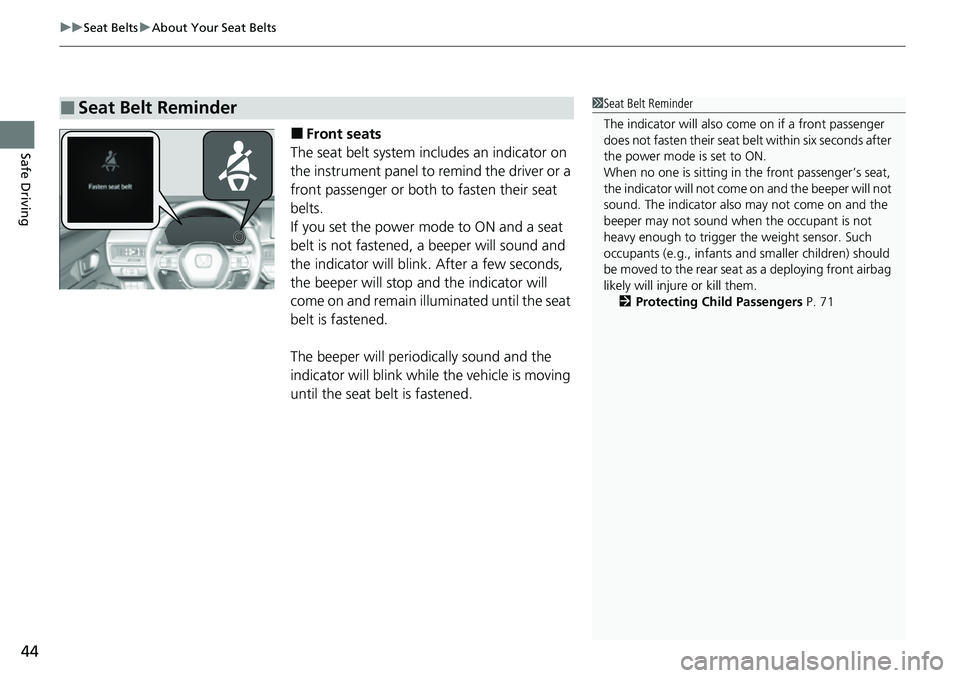
uuSeat Belts uAbout Your Seat Belts
44
Safe Driving■Front seats
The seat belt system in cludes an indicator on
the instrument panel to remind the driver or a
front passenger or both to fasten their seat
belts.
If you set the power mode to ON and a seat
belt is not fastened, a beeper will sound and
the indicator will blink. After a few seconds,
the beeper will stop and the indicator will
come on and remain illuminated until the seat
belt is fastened.
The beeper will periodically sound and the
indicator will blink while the vehicle is moving
until the seat belt is fastened.
■Seat Belt Reminder1 Seat Belt Reminder
The indicator will also co me on if a front passenger
does not fasten their seat be lt within six seconds after
the power mode is set to ON.
When no one is sitting in th e front passenger’s seat,
the indicator will not come on and the beeper will not
sound. The indicator also may not come on and the
beeper may not sound when the occupant is not
heavy enough to trigger th e weight sensor. Such
occupants (e.g., infants and smaller children) should
be moved to the rear seat as a deploying front airbag
likely will injure or kill them.
2 Protecting Child Passengers P. 71
Page 53 of 700
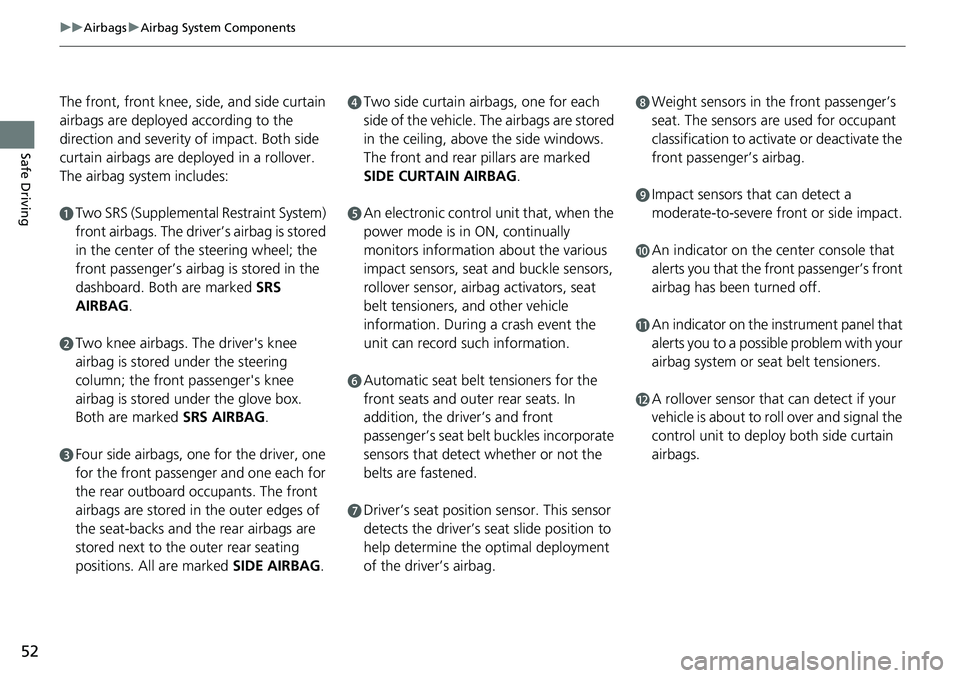
52
uuAirbags uAirbag System Components
Safe Driving
The front, front knee, si de, and side curtain
airbags are deployed according to the
direction and severity of impact. Both side
curtain airbags are depl oyed in a rollover.
The airbag system includes:
aTwo SRS (Supplemental Restraint System)
front airbags. The driver’s airbag is stored
in the center of the steering wheel; the
front passenger’s airbag is stored in the
dashboard. Both are marked SRS
AIRBAG.
bTwo knee airbags. Th e driver's knee
airbag is stored under the steering
column; the front passenger's knee
airbag is stored under the glove box.
Both are marked SRS AIRBAG.
cFour side airbags, one for the driver, one
for the front passenger and one each for
the rear outboard occupants. The front
airbags are stored in the outer edges of
the seat-backs and the rear airbags are
stored next to the outer rear seating
positions. All are marked SIDE AIRBAG.
dTwo side curtain airbags, one for each
side of the vehicle. The airbags are stored
in the ceiling, above the side windows.
The front and rear pillars are marked
SIDE CURTAIN AIRBAG .
eAn electronic control unit that, when the
power mode is in ON, continually
monitors information about the various
impact sensors, seat and buckle sensors,
rollover sensor, airbag activators, seat
belt tensioners, and other vehicle
information. During a crash event the
unit can record such information.
fAutomatic seat belt tensioners for the
front seats and outer rear seats. In
addition, the driver’s and front
passenger’s seat belt buckles incorporate
sensors that detect whether or not the
belts are fastened.
gDriver’s seat position sensor. This sensor
detects the driver’s seat slide position to
help determine the optimal deployment
of the driver’s airbag.
hWeight sensors in the front passenger’s
seat. The sensors are used for occupant
classification to activa te or deactivate the
front passenger’s airbag.
iImpact sensors that can detect a
moderate-to-severe front or side impact.
jAn indicator on the center console that
alerts you that the front passenger’s front
airbag has been turned off.
kAn indicator on the instrument panel that
alerts you to a possib le problem with your
airbag system or seat belt tensioners.
lA rollover sensor that can detect if your
vehicle is about to roll over and signal the
control unit to deploy both side curtain
airbags.
Page 56 of 700

Continued55
uuAirbags uFront Airbags (SRS)
Safe DrivingFront airbags are designed to inflate duri ng moderate-to-severe frontal collisions.
When the vehicle decelerates suddenly, the sensors send information to the control
unit which signals one or both front airbags to inflate.
A frontal collision can be either head-on or angled between two vehicles, or when a
vehicle crashes into a stationary object, such as a concrete wall.
While your seat belt restrains your torso, the
front airbag provides supplemental protection
for your head and chest.
The front airbags deflate immediately so that
they won't interfere with the driver's visibility
or the ability to steer or operate other
controls.
The total time for inflation and deflation is so fast that most occupants are not
aware that the airbags deployed until th ey see them lying in front of them.
■Operation
■How the Front Airbags Work1How the Front Airbags Work
Although the driver's and fr ont passenger's airbags
normally inflate within a spli t second of each other, it
is possible for only one airbag to deploy. This can
happen if the severity of a collision is at the margin,
or threshold, that determines whether or not the
airbags will deploy. In such cases, the seat belt will
provide sufficient protec tion, and the supplemental
protection offered by the airbag would be minimal.